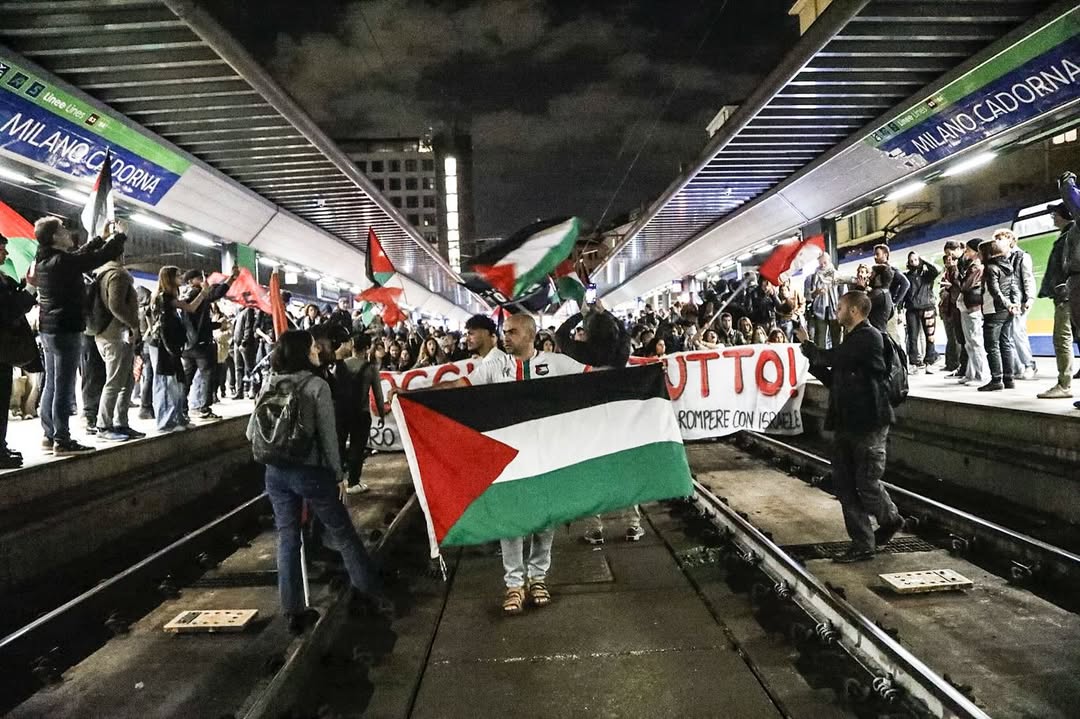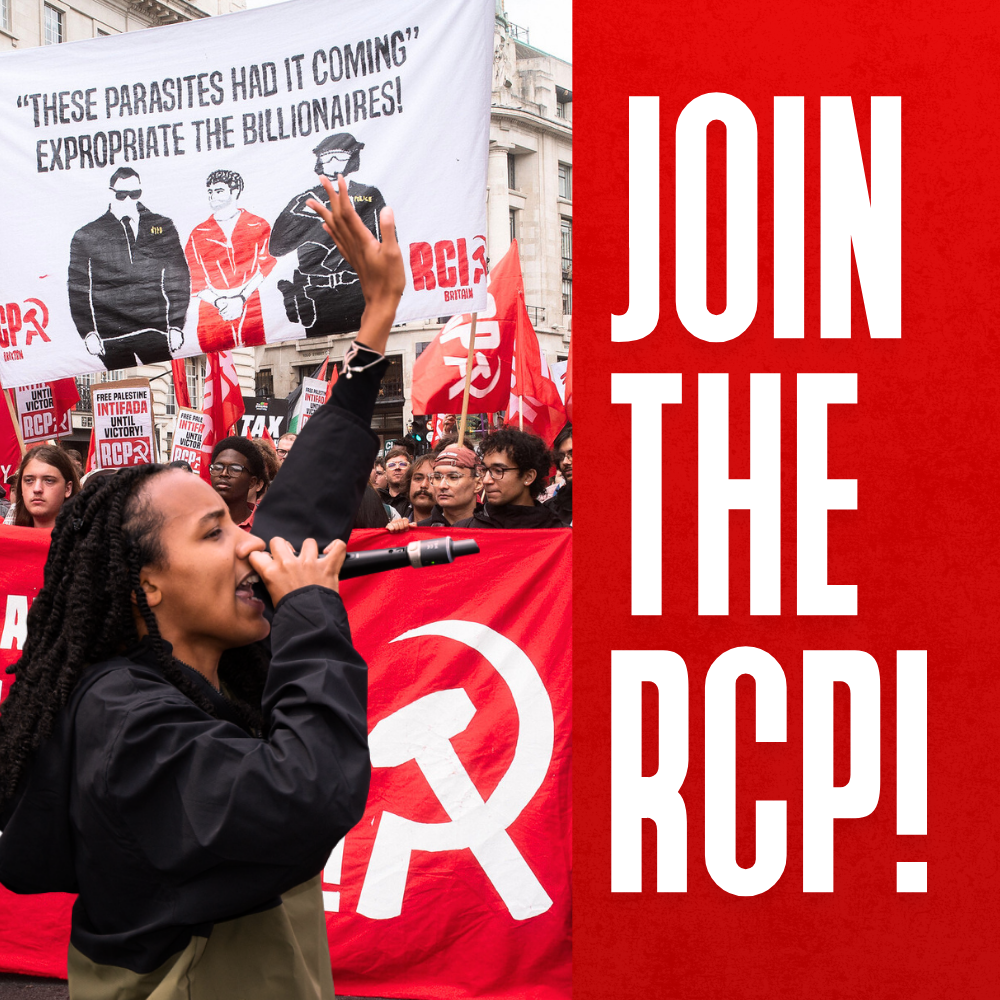What happened in Italy on Friday 3 October has very few precedents. Think about it. A political strike. A political general strike. A political general strike over internationalist solidarity and against imperialism.
Millions participated in industrial action, two million participated in mass demonstrations and hundreds of thousands took direct action under the slogan of “let’s block everything”. The following day, Saturday 4 October, over a million turned out in Rome for a national demonstration against the genocide in Gaza. These events are part of a dramatic turn in the world situation, which is not limited to Italy, but includes the mass movement in France, mass protests in Spain, and the so-called Generation Z revolutions, all together adding to a Red September. It is important to analyse them, understand their main features and implications.
What are the main features of the movement in Italy?
First of all, we need to highlight that this movement has emerged from outside the mass traditional organisations. The leaders of the CGIL, Italy’s largest trade union confederation, were forced to call it, after having been outflanked by the mass movement of hundreds of thousands of workers and youth on 22 September during the general strike for Palestine called by the smaller USB union.
The second striking characteristic of the movement is the role of the youth, which were at the forefront of the mobilisation everywhere, present in large numbers (even CGIL general secretary Landini had to mention this fact), coming out together with the rest of the working class and the population in general.
A third dominant feature of the Italian events of the last two weeks is the strong feeling amongst the masses that simply demonstrating is not enough, that something more needs to be done. The slogan of the general strike, “Block everything,” adopted from the movement in France, represents a healthy instinct, recognising that exercising moral pressure on governments achieves nothing and that direct action is needed. This idea contains, in an embryonic form, the germ of revolution, when the masses take matters into their own hands.
Fourth, and perhaps one of the most important features of the movement is the direct action of dockworkers to refuse to handle cargo going to and from Israel. This has been conducted through strike action by the dockers themselves (in Genoa, Livorno and other ports) backed by the mass mobilisation of outside support. This is extremely significant. There had been other instances of such action (in Marseille, Piraeus) previously, but the Italian dockers have taken this to a higher level.
The initiative of the Italian dockers needs to be spread and coordinated at an international level. The European dockworkers conference in Genoa was an excellent first step forward. A workers’ boycott of Israel would have a massive impact, both from a practical and a political point of view, as it would severely hinder the Israeli war machine while clearly raising the power of the working class in capitalist society.
Fifth, the huge movement of the Italian workers and youth, in a country ruled by a government of the demagogic reactionary right wing is a slap in the face to all those skeptics, cynics and demoralised elements on the so-called left, who have spent the whole year pathetically whining about the so-called rise of fascism, reaction and Bonapartism.
The collapse of legitimacy of all bourgeois institutions (as a result of the organic crisis of capitalism) has given rise to a deep anti-establishment mood. Because of the bankruptcy of the ‘Left’ this has expressed itself, in many instances, in the rise of right-wing demagogues, who have channeled this mood of anger in a reactionary direction, scapegoating migrants, etc. The government of Meloni is a case in point.
This is not an inevitable outcome – given half an opportunity, the same mood will be and has been expressed in an explosion of the class struggle. That is the only way to fight the right and reaction: by militant struggle along class lines – not culture wars, not the abstract ‘defence of democracy’ or ‘the institutions’ or ‘the Republic’ – but class struggle against the capitalist establishment as a whole.
Sixth, the Italian eruption has taken place over the question of the Flotilla and in opposition to the genocide in Gaza, but it has deeper roots. Gaza has acted as a catalyst for a mass movement of protest which was long overdue. Years of austerity policies, cuts in social spending, attacks on healthcare and education, the erosion of living standards (particularly marked in Italy since 2008), intensification of the exploitation at work, the casualisation of labour conditions… all of these social and economic pressures had accumulated and were desperately looking for a channel of expression.
The leaders of the trade unions – which have, in effect, become completely wedded to the capitalist establishment – were mortally afraid to provide such a channel. The accumulated pressure boiled over on the question of Palestine, but was in reality also a mass protest movement against the right-wing government and the whole system. The movement is unleashing forces the leaders can’t hope to control.
In Italy, the movement against the Israeli genocide in Gaza has gone from strength to strength: from the mass movement on 22 September to the general strike on 3 October and the huge national demonstration in Rome. At some point this phase of the movement will inevitably ebb, but its impact will be long-lasting and will reverberate beyond the question of Palestine solidarity, spreading into all aspects of the struggle of workers and youth, including in the industrial struggle for wages and conditions.
The workers and youth have had a taste of their own power vis-à-vis the government and the bosses. They are now confident and this confidence is likely to propel them on the offensive on other fronts. As the Italian comrades of the Partito Comunista Rivoluzionario (PCR) point out, “the dam has burst”.
Over one million people in Italy joined a nationwide strike and protests in solidarity with the Global Sumud Flotilla after Israeli raids on all 42 vessels. The strike—organized by the country’s two largest unions, representing 5.5 million workers—brought the transport system to… pic.twitter.com/speAUPrvht
— BreakThrough News (@BTnewsroom) October 3, 2025
Movement spreading across Europe
These are the main features of the movement in Italy, but they are not unique to Italy. Over the weekend, there were unprecedented mass demonstrations in solidarity with Palestine across Spain which involved a total of two million people.
The tendency towards direct action is also present here, though in a weaker form, with attempts to blockade highways and the harbour in Barcelona. The union leaders have been forced to call for limited strike action on 15 October, with some unions calling for a 24 hour strike on the same day in Catalonia, the Basque Country and Galicia.
In France, the “let’s block everything” (bloquons tout) movement led to two massive days of action on 10 and 18 September directed against the government and against Macron, which are attempting to carry out massive austerity cuts. This has now led to the resignation of French prime minister Lecornu after just 27 days in office and 24 hours after forming his cabinet.
In Spain and Italy, the initiative for these massive mobilisations came from below, not from the leaders of the trade unions nor from the left political parties. In both cases, the youth played the most dynamic role.
In several other European countries there were unprecedented mobilisations in solidarity with Palestine and militant demonstrations against the Israeli assault on the Flotilla (Germany, Belgium, Ireland, Portugal, Switzerland, Netherlands etc.). To this we have to add the general strike in Greece (1 October) against the counter-reform of the labour law, which is also the continuation of the explosive mobilisations and general strike over the cover up of the Tempi railway disaster.
250,000 in today’s Red Line for Palestine in Amsterdam, the largest ever. A worldwide outpouring of support. Italy shows the way: general strike, workers boycott, mass direct action. Down with the warmongers. Free Palestine. End the genocide. pic.twitter.com/Xhw8fYl37h
— Jorge Martin ☭ (@marxistJorge) October 5, 2025
The worldwide current of the Generation Z revolution
These events represent the entry of advanced capitalist countries in Europe and their working class and youth into the worldwide current of the ‘Gen Z revolution’, which has rocked country after country over the last month (Indonesia, Nepal, East Timor, Philippines, Madagascar, Morocco, Paraguay, Ecuador, Peru…)
Worldwide, there is a generation of youth which came of age after the 2008 capitalist crisis and has grown up in the context of austerity cuts, mass movements and revolutions, the impact of the COVID-19 pandemic, the environmental crisis, the growing gulf between the rich and the poor, wars and militarism. The combination of all of these factors has led to a loss of legitimacy of all bourgeois institutions and parties, the mass capitalist media, parliaments, etc.
The accumulation of anger at the capitalist crisis and its varied manifestations has now exploded into a worldwide chain of mass movements, insurrections, uprisings and revolutions. This represents a dramatic turn in the world situation. The youth is at the forefront of this movement and they have an instinctively internationalist approach, learning from each others’ movements, drawing inspiration from them. This is reflected in the use of the same slogans and banners, including the pirate flag of the Straw Hat Crew.
Only the complete bankruptcy of the official left prevents these movements from going even further, or else, when they do rise to the level of achieving the revolutionary overthrow of a government or a regime, they are then diverted back into cosmetic changes at the top so that nothing fundamentally changes.
The masses have shown, once and again, enormous determination and courage to struggle, when given the opportunity, sometimes in a completely spontaneous way and against all odds. What has been strikingly lacking everywhere is a revolutionary leadership worthy of the name, able to lead the movement to decisive victory. The task of building such a revolutionary communist leadership is more urgent than ever.
How to free Palestine?
The Italian general strike represents the highest point of the Palestine solidarity movement and an inspiration to workers and youth of the world. In Italy itself, the enormous pressure of mass mobilisation, of the masses of workers and youth in action, has completely transformed the balance of forces. The right-wing government is on the defensive.
The CGIL and PD (Democratic Party) leaders are forced to tack left for fear of being brushed aside. The initiative is on the side of the mass movement. It is the time to push forward and go further. The movement should adopt a series of specific demands (complete embargo of Israel, breaking of diplomatic relations, etc.) and threaten a 48 hour strike if they are not met within a given period of time.
The Italian general strike shows the way forward for the Palestine solidarity movement everywhere: strikes, mass direct action, blocking everything, workers’ boycott. These are the methods which must be adopted.
View this post on Instagram
The Genoa conference of dockworkers issued a call for a European and Mediterranean-wide dockworkers’ day of action against the genocide. That is an excellent initiative which should serve as the basis for an international workers’ boycott of Israel involving dockworkers and other transport workers, as well as workers in the weapons industries.
There are various factors that have led Trump towards attempting to push forward a ‘peace deal’ in Gaza, against the will of Netanyahu. That is not the subject of this statement. Suffice it to say that the explosion of the mass movement against the genocide and specifically the Italian eruption have clearly played a role.
Both Marco Rubio and Trump himself admitted as much when they said that “Israel’s international isolation was one of the reasons the war in Gaza has to end”. US imperialism and Israel’s allies and sponsors in Europe have a mortal fear of the revolutionary consequences of the massacre in Gaza for the reactionary Arab regimes they back in the region but also the radicalising impact it is having at home.
Let’s be clear, Trump’s Gaza plan is a trap. What he is offering the Palestinians is a deadly choice between genocide and ethnic cleansing on the one hand and a colonial mandate enclave ruled directly by Trump and Blair. It is a second, even crueller edition of the failed Oslo Accords, the first time as tragedy, the second time as farce.
Palestine can only be freed by revolutionary means, starting with the overthrow of the reactionary Arab and Muslim regimes which act as necessary accomplices of her oppression. The masses of workers, youth and poor people in Egypt, Jordan, Lebanon, Turkey, Saudi Arabia need to draw inspiration from the Italian general strike and follow its example.
The struggle for Palestine cannot be seen in isolation. In the West, it is first and foremost a struggle against our own imperialist governments, which are complicit with the Israeli genocide in Gaza. These are the same governments which impose brutal austerity measures on workers and youth, while demanding massive increases in military spending. The struggle against the Gaza genocide must be linked to the struggle against austerity at home. The Italian methods of struggle are not just the only way forward for the Palestine solidarity movement, but also for the movement of workers and youth in general, over wages and conditions, over housing, against military spending and for healthcare and education.
The Italian general strike on 3 October, and more generally the whole Red September of 2025, are a source of tremendous inspiration. It is our duty to draw all the necessary lessons and generalise them.
London, 6 October 2025
Originally posted on Marxist.com






